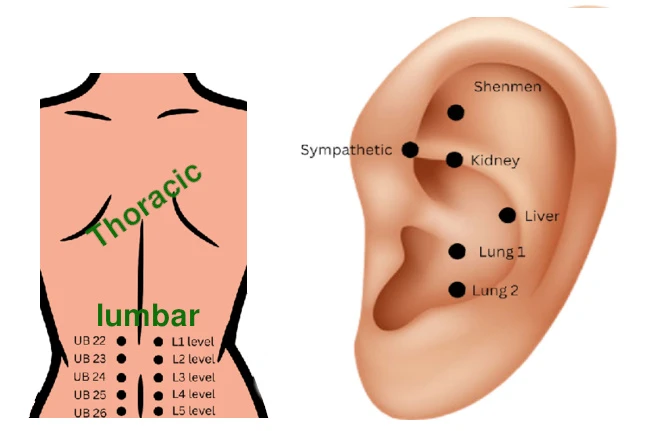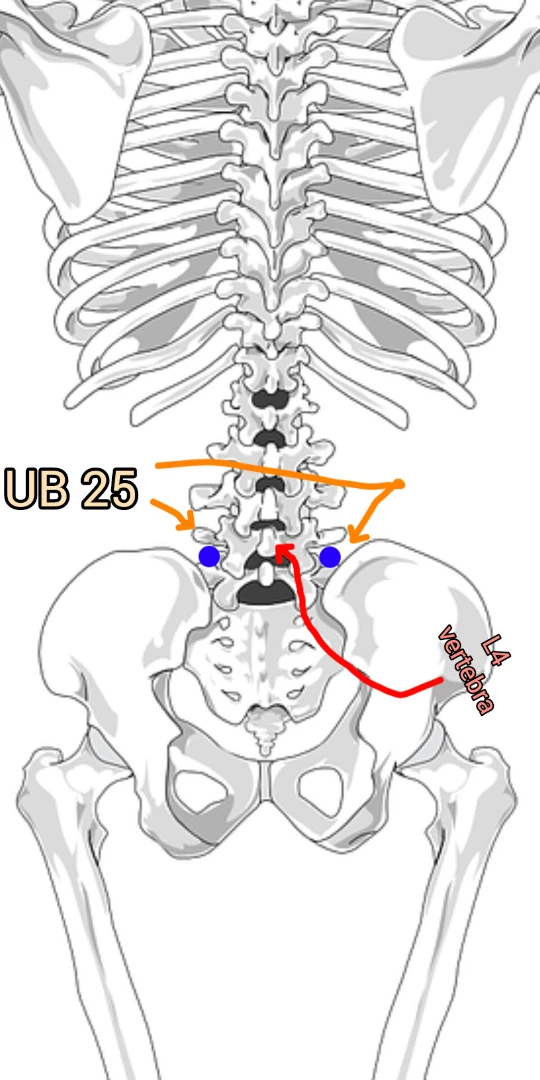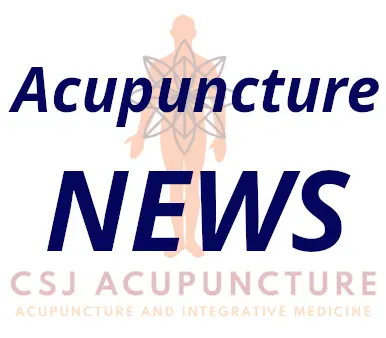In the world of acupuncture, there are certain points that stand out for their versatility and effectiveness. One of these is UB 25, also known as Urinary Bladder 25 (Da Chang Shu, “Large Intestine Back Transporting Point”) —a fantastic point that I used constantly in my practice, and for good reason. Known as the Back Shu point of the Large Intestine, UB 25 offers a powerful way to address common health issues, particularly those related to the back.
Contents
Point Location Of UB 25
UB 25 is located 1.5 cun lateral to the fourth spinous process of the lumbar vertebrae (L4).1
This location is significant because many patients experience issues such as disc problems at L3, L4, and L5. These disc issues often manifest as chronic pain or conditions like sciatica.
Neurons that innervate the large intestine are located at the level of the 8th thoracic vertebra through the 2nd Lumbar vertebra.2

Needle Depth of UB 25
When you’re needling UB 25, it’s important to consider the appropriate needle depth. Generally, 1 cun is a good standard depth to aim for, but you can go up to 1.5 cun, especially since you’re working in the low back region. For most patients, a 1.5 cun needle is perfectly acceptable to use. However, if a patient has a smaller waist circumference, you’ll need to adjust accordingly.
In these cases, you might find that a 1.5 cun needle is too deep, and you may need to scale back to even a 0.5 cun needle. It’s important to use your judgment here—there’s no one-size-fits-all approach. Each patient is unique, and the depth of needling should be tailored to their specific anatomy. Remember, it’s not necessary to hit exactly 1.5 cun every time. What matters most is performing an accurate objective assessment to determine the best treatment for each individual.

Benefits of UB 25
- Relieves back pain: Whether it’s due to poor posture or long periods of sitting, UB 25 can help alleviate tension and discomfort in the lower back.
- Supports digestive health: Since it’s associated with the Large Intestine, UB 25 is also useful for addressing digestive issues like
- Boosts circulation: By stimulating UB 25, we can enhance blood flow to the lower back, helping to reduce stiffness and promote healing.
It’s a point I return to time and time again, not only because of its immediate benefits for back pain but also for its wider influence on overall health, particularly through its connection to the Large Intestine.
The Back Shu Point of the Large Intestine
UB 25 is particularly special because it’s the Back Shu point of the Large Intestine. In Traditional Chinese Medicine (TCM), Back Shu points are considered to be highly influential in treating disorders related to their corresponding organs. In this case, UB 25 directly influences the Large Intestine, making it valuable not just for back problems but also for issues related to digestion and bowel function.
When addressing back shu points like UB 25, it’s essential to understand that they are generally used to tonify or strengthen. In Traditional Chinese Medicine (TCM), tonifying points are utilized to invigorate or replenish the body’s Qi and essential energies. These points help address deficiencies or weaknesses, making them a go-to for conditions where the body needs reinforcement, such as in cases of fatigue or chronic pain.
On the other hand, front shu points serve a different function. They are often applied in treatments focused on relaxation and sedation. These points do not aim to invigorate but rather to calm and balance the system, helping to alleviate stress and regulate the body’s fight-or-flight response. Essentially, front shu points are more geared toward soothing the body and mind, promoting a state of equilibrium, which can be particularly beneficial when addressing excess or hyperactive conditions.
Why UB 25 is So Important
Here in the United States, many people suffer from back problems, and this is largely due to our sedentary lifestyle along with other factors. Whether it’s sitting at desks for hours or lounging on the couch, our backs take the brunt of our modern way of living. This is where UB 25 comes into play. Located on the lower back, UB 25 can help alleviate pain, improve circulation, and restore balance to the body. I find myself using it daily with patients because it’s such a go-to point for back issues.
Combining Points With UB 25
UB 25 is also frequently used in combination with UB 23, the Back Shu point of the Kidneys. This pairing is a powerful method for addressing lower back pain, particularly when related to conditions like spondylosis, spondylolisthesis, or impingement issues. Together, these points are especially effective in treating sciatica, as the Kidney system in TCM governs the lower back and spine. UB 23 helps strengthen the Kidneys and tonifies the underlying deficiency, while UB 25 works to promote the flow of Qi along the Large Intestine meridian, targeting stagnation and discomfort. This combination provides relief from both the structural and energetic causes of lower back pain, offering a holistic approach to treatment.
UB 23 isn’t the only point you can combine with UB 25. Another highly effective combination is with SI 3 (Small Intestine 3), which we’ll cover in more detail in the future. SI 3 is an essential point on the Small Intestine meridian, known for its strong benefits in treating neck and back pain. When paired with UB 25, this combination can be particularly effective for low back issues, further enhancing the treatment’s impact on the spinal area.
Additionally, there are is Yao Tong Xue (known as “point of the lower back”3), a set of “extra points” frequently used for back pain. Yao Tong Xue points, when combined with UB 25, offer a powerful solution for treating a variety of back problems. This combination is commonly utilized to treat acute low back pain, adding versatility to the range of acupuncture techniques for back-related issues.
Acupressure and Cupping on UB 25
Acupressure can be applied to UB 25, and has been used in conditions such as irritable bowel syndrome.4
Cupping is a great treatment method for tight lumbar and other low back muscles.
Considerations and Cautions for UB 25
As with all points, there are special circumstances when using this point is not ideal which we’ll examine. This is not a full detailed list, but rather an overview of precautions.
After Evaluation of Serious Injury
When using UB 25 in treatment, it’s important to understand that while it can be highly effective for pain management and symptom relief, it won’t heal structural damage like a fractured disc. Such injuries typically require consultation with an orthopedic specialist or a primary care doctor, followed by appropriate medical therapies. Once a patient is under care for these more severe conditions, UB 25 can be integrated to relieve pain and tension in the lower back.
The spine, once damaged, can be difficult to repair fully. Damage tends to be long-lasting and may require careful management over time. However, acupuncture at UB 25 often provides immediate relief for some patients, while others may need several treatments to experience significant improvement. On average, many patients see results within five treatments or more, depending on the severity of their condition.
Geriatric Patients
I often say that UB 25 is excellent for reversing patterns of stagnation and disharmony in the body. It’s an invigorating point, which is why I frequently use it with geriatric patients, particularly those experiencing chronic low back pain or issues in the lower extremities. This point helps to move Qi and alleviate muscle strain, promoting more vitality in the body.
Some geriatric patients may need to adjust how they are lying down, for instance by lying o
Respect for Patient and Proper Manners
It’s important to note that needling UB 25 involves exposing the lower back, so it’s essential to inform patients beforehand. Ensuring that they are comfortable with the procedure and providing proper covering is a priority. Every patient should feel respected, and maintaining their dignity during treatment is crucial.
Research on UB 25
Research on UB 25 has shown it’s ability to improve conditions such as irritable bowel syndrome, abdominal distension, constipation, hemorrhoids and diarrhea5.
A 2018 meta analysis showed that acupuncture points used at the location of discomfort along with distal acupuncture points was superior to just only using local point or distal points, which included the use UB 25.6
A 2010 randomized controlled study (RCT) of 100 patients suggested that electro-acupuncture may offer benefits for chronic low back pain.7 Limitations of the study should be noted, and warrants further research with rigorous methodological standards. With that said, I’ve always have been interested in more research to find the most usefulness and effectiveness of points.
Clinical Insights Summary
UB 25 offers clear clinical indications, especially when assessing patients with limited range of motion and tenderness8 at the site of pain. Often, by the time patients present with these symptoms, they’ve already tried various treatments that haven’t worked, which can make it easier to apply an effective acupuncture regimen and evaluate its success. While more research could help uncover additional applications for UB 25, its power and versatility in clinical settings are already well-established. When you understand the underlying anatomical structures beneath this point, its effectiveness becomes even more fascinating.
Want more insights into integrative healthcare and well-being? Sign up of our FREE newsletter below and stay on top with one of the most informative websites based on experience and research!
- Wal, A., Debnath, B., Verma, N., Bhattacharya, S., Shivajirao Solunke, R., Masih Uzzaman Khan, M., & Wal, P. (2022). Role of Herbal Medicine, Acupressure and Acupuncture in the Treatment of Irritable Bowel Syndrome. IntechOpen. doi: 10.5772/intechopen.108757 ↩︎
- Cabioglu MT, Arslan G. Neurophysiologic basis of Back-Shu and Huatuo-Jiaji points. Am J Chin Med. 2008;36(3):473-479. ↩︎
- Kim HB. Acupuncture & Oriental Medicine: A Comprehensive Text (3rd ed.). Jamison, PA: TKM Publishing; 2016:247. ↩︎
- Wal, A., Debnath, B., Verma, N., Bhattacharya, S., Shivajirao Solunke, R., Masih Uzzaman Khan, M., & Wal, P. (2022). Role of Herbal Medicine, Acupressure and Acupuncture in the Treatment of Irritable Bowel Syndrome. IntechOpen. doi: 10.5772/intechopen.108757 ↩︎
- Wal, A., Debnath, B., Verma, N., Bhattacharya, S., Shivajirao Solunke, R., Masih Uzzaman Khan, M., & Wal, P. (2022). Role of Herbal Medicine, Acupressure and Acupuncture in the Treatment of Irritable Bowel Syndrome. IntechOpen. doi: 10.5772/intechopen.108757 ↩︎
- an KH, Cho KH, Han C, Cui S, Lin L, Baek HY, Kim J. The effectiveness and safety of acupuncture treatment on sciatica: A systematic review and meta-analysis. Complement Ther Med. 2022;71:102872. doi:10.1016/j.ctim.2022.102872. ↩︎
- Mu J, Furlan AD, Lam WY, Hsu MY, Ning Z, Lao L. Acupuncture for chronic nonspecific low back pain. Cochrane Database Syst Rev. 2020;12(12):CD013814. Published 2020 Dec 11. doi:10.1002/14651858.CD013814 ↩︎
- Rybicka, Monika & Gąsowski, Jerzy & Przeklasa-Muszyńska, Anna & Dobrogowski, Jan & Wierzbicka, Jagoda & Hui, Ka-Kit & Ptasnik, Sara & Kocot-Kępska, Magdalena. (2024). NADA Ear Acupuncture and Medical Acupuncture for Pain- and Health-Related Quality of Life among Older Patients with Chronic Nonspecific Low Back Pain: A Prospective Clinical Trial. Brain Sciences. 14. 205. 10.3390/brainsci14030205. ↩︎
Medical Disclaimer: This article is for informational and educational purposes only and is not a substitute for professional medical advice, diagnosis, or treatment. Always consult a qualified healthcare provider with any questions about a medical condition or treatment.


 Optimizing Humans Since 2004 Shop Now!
Optimizing Humans Since 2004 Shop Now!


